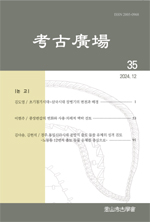경주 통일신라시대 공방지 출토 동물 유체의 성격 검토 - 노동동 12번지 출토 동물 유체를 중심으로
A Study on the Characteristics of Animal Bones Excavated from the Site of the Workshop in Unified Silla Period, Gyeongju : Based on the animal bones at excavated in Nodong-dong No. 12
- 28

이 연구는 노동동 12번지에서 출토된 통일신라 동물 유체를 재분석하여 그 성격을 검토한 것이다. 노동동 12번지는 다양한 생활유구와 공방 관련 유물이 출토되어 공방지가 있었음이 확인되었다. 출토된 동물 유체에서 다수의 해체흔이 확인되어 공방지에서 사용했을 가능성을 두었다. 총 277점의 동물 유체를 분석한 결과, 13종의 동물이 확인되었으며, 소와 말이 70%를 차지하고 추정 연령은 성수가 가장 많이 확인되어 선택적 도살이 이루어졌을 것으로 추정한다. 노동동 12번지의 분석결과를 바탕으로 동물 유체가 확인된 경주 지역 내 공방지 성동동 386-6번지와 황남동 376번지를 함께 비교하여 통일신라시대 공방지 출토 동물 유체의 이용양상 및 성격에 대해 고찰하였다. 세 유적 모두 소와 말의 비율이 높았으며, 이는 삼국시대와 달리 변화된 도구의 생산 및 수요 양상을 나타낸다. 또한 출토 부위를 확인해 본 결과, 노동동 12번지에서만 말단부가 확인되어 해체와 폐기가 동시에 이루어진 장소로 추정되었고 공방과 주거지에서의 동물 유체의 사용이 혼재했을 것으로 보이며, 지배층의 사영 공방지로 고려된다. 또한 모든 유적에서 확인된 두개골 절단흔적은 뇌수를 이용하기 위한 것으로 가죽생산과정인 무두질의 매제로 사용된 것으로 생각되며, 해체방법은 삼국시대의 방법이 그대로 이어져 오고 있었다. 이러한 두개골의 흔적은 통일신라시대 내 말과 소의 가죽의 수요가 높아짐에 따라 각 사영 공방에서도 개별적인 가죽제작공정이 있었던 것으로 추정된다. 앞으로 더 많은 통일신라시대 동물 유체 자료가 축적된다면 지금보다 명확한 통일신라시대 동물 이용양상 및 활용방법에 대해서 알 수 있을 것이라고 기대한다.
This study reanalyzes animal bones excavated from site in Nodong-dong No.12 to examine their characteristics. The site has revealed various domestic structures and artifacts related to workshops, confirming its function as a production area. Numerous disassembly marks found on the excavated animal bones suggest their use within this workshop context. Analysis of a total of 277 animal bones identified 13 species, with cattle and horses accounting for 70% of the findings. The majority of these animals were determined to be in their adults age, indicating selective slaughter practices. Based on the findings from Nodong-dong, this research compares the usage patterns and characteristics of animal bones from two other production sites in Gyeongju: Site in Seongdong-dong No. 386-6 and Site in Hwangnam-dong No. 376. All three sites exhibited a high proportion of cattle and horses, reflecting a shift in production and demand patterns compared to the Three Kingdoms period. Notably, only Nodong-dong No.12 had revealed phalanges, suggesting simultaneous disassembly and disposal, indicating a mixed use of animal bones in both workshop and residential contexts, and it is considered a private workshop for the ruling class. Additionally, the presence of cut marks on skulls across all sites indicates the utilization of brain, potentially for the leather tanning process. The disassembly methods observed appear to have continued from the Three Kingdoms period. These skull marks suggest that there was a significant demand for horse and cattle hides during the Unified Silla period, individual leather production processes existed in each workshop for the ruling class. Future accumulation of more data on animal bones from the Unified Silla period is anticipated to provide clearer insights into the patterns and methods of animal resource utilization during this era.
Ⅰ. 머리말
Ⅱ. 노동동 12번지 출토 동물 유체 분석
Ⅲ. 노동동 12번지 동물 유체 특징
Ⅳ. 경주 지역 내 공방 유적 간의 비교 검토
Ⅴ. 맺음말
(0)
(0)